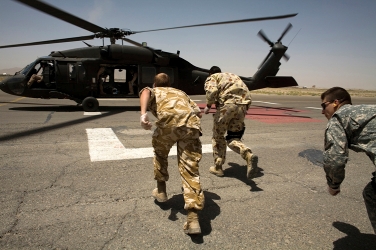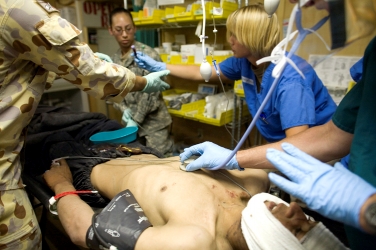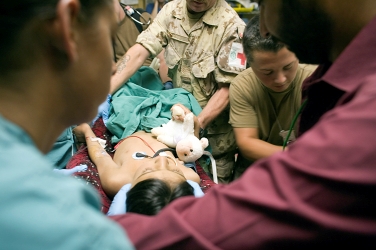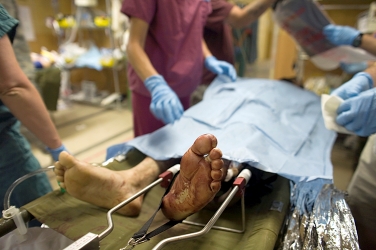 |
Nine Lines From the Front
July 2006 |
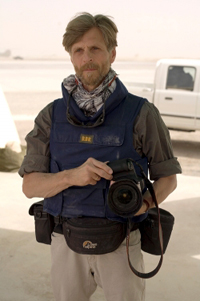 |
|||||||||||||||
|
It's barely dawn, 4:00 in the morning and cool by summer standards. In a few hours the temperature will climb steeply, like it did yesterday and as it will tomorrow – 40-plus degrees C (93+F), with no clouds in sight. Joggers slog by, their reflective safety belts slapping at their sides. The running shoes they wear crunch at the dusty cinders, squeezed to the roadside. The din of a helicopter from the flight-line a half-kilometer away is a constant sound, an annoying sound and – somehow - a comforting one, too.
"We're taking small-arms and machine-gun fire," crackles a voice from the radio at the corner of the administration desk at the hospital. A Canadian soldier is manning this station when I arrive. On the wall in front of him, red type appears letter-by-letter on the "Big Screen," new details posted in the nine-line standard format, profiling each of the in-coming battlefield wounded. The soldier keys a response to his laptop and turns briefly toward me.
During the wait, I walk through the 19-bed critical-care ward noting changes from when I left five hours ago. Lights were dim in the room where patients sleep. In a corner, an Afghan civilian raises his head from the floor and lies back down again. He stands vigil over his 8-year-old niece who arrived from Zabul province several days ago with gunshot wounds to the abdomen. There is an official explanation of where the bullet came from.
I came to this embed with expectations of covering the fight at the "front line," a constantly morphing entity. The KAF hospital story arrived through the back door -- literally.
Spending time in the Public Affairs Office waiting for flights and opportunities, details of the hospital came through casual conversation. "Is that something you'd be interested in?" asked the Army Major in charge. "Yeah, maybe," I said. A few phone calls later and I was escorted from the rear of the TLS (Taliban's Last Stand) building, past the coffee shop, the PX and into the front office of the medical center. My request was presented and administration there said, "Yes." It was a go.
The story was a unique one, not only due to the fact that this small military hospital was capable of providing care at the level of a small city hospital back in the States, but because it was staffed by military medical professionals from Canada, Holland, England, Australia and the United States who worked effectively together to make that happen on a 24/7 basis. They'd performed 250 battlefield-related surgeries since coming here in February and since then have seen two to three Medevac cases on average per day.
Checking the time, I walk to the tarmac where choppers would land. A pair of Army ambulances sits poised at the flight-line, their crews talking quietly in the shade of open doors. Within minutes, two faint spots appear low in the sky, seemingly held up by haze and dust far down the runway. In seconds they hover meters above us. Rotor-wash throws sand and stones point-blank. Sunglasses go on, earplugs go in and I follow the line of paramedics to the rocking and then settling machines. Shooting close and wide-angle, I hold as close as I can to the action as the three wounded are pulled from the two Blackhawks and whisked to the vans. I turn and sprint to the hospital's emergency door 150 meters away. When I get there personnel are waiting astride the thick yellow line leading straight to the ER. It's all a bit surreal – like an episode from the TV series of the same name. The pace is quick, calculated and cool. From wherever they hail, each knows his/her job. I move in and out of vacant spaces, watching peripherally as much as I can while looking through the viewfinder. I carefully move closer doing my best not to show faces that remain recognizable.
There was no connection between these men and I, save for the images I had captured. That and the fact that I had wanted to go where they just came from. Returning the next morning, I walk past the Big Screen and its defining lines of info and glance at the marker board, opposite. Written in longhand, the message on the status of patients was there: "All three from yesterday still live."
© David Bathgate
Dispatches are brought to you by Canon. Send Canon a message of thanks. |
||||||||||||||||
Back to July 2006 Contents
|
|
